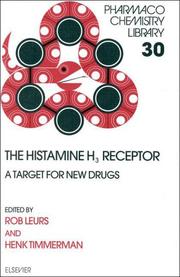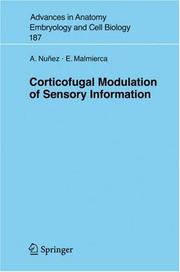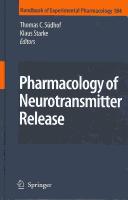| Listing 1 - 10 of 18 | << page >> |
Sort by
|
Book
Year: 2014 Publisher: Frontiers Media SA
Abstract | Keywords | Export | Availability | Bookmark
 Loading...
Loading...Choose an application
- Reference Manager
- EndNote
- RefWorks (Direct export to RefWorks)
The most biologically-inspired artificial neurons are those of the third generation, and are termed spiking neurons, as individual pulses or spikes are the means by which stimuli are communicated. In essence, a spike is a short-term change in electrical potential and is the basis of communication between biological neurons. Unlike previous generations of artificial neurons, spiking neurons operate in the temporal domain, and exploit time as a resource in their computation. In 1952, Alan Lloyd Hodgkin and Andrew Huxley produced the first model of a spiking neuron; their model describes the complex electro-chemical process that enables spikes to propagate through, and hence be communicated by, spiking neurons. Since this time, improvements in experimental procedures in neurobiology, particularly with in vivo experiments, have provided an increasingly more complex understanding of biological neurons. For example, it is now well understood that the propagation of spikes between neurons requires neurotransmitter, which is typically of limited supply. When the supply is exhausted neurons become unresponsive. The morphology of neurons, number of receptor sites, amongst many other factors, means that neurons consume the supply of neurotransmitter at different rates. This in turn produces variations over time in the responsiveness of neurons, yielding various computational capabilities. Such improvements in the understanding of the biological neuron have culminated in a wide range of different neuron models, ranging from the computationally efficient to the biologically realistic. These models enable the modelling of neural circuits found in the brain. In recent years, much of the focus in neuron modelling has moved to the study of the connectivity of spiking neural networks. Spiking neural networks provide a vehicle to understand from a computational perspective, aspects of the brain's neural circuitry. This understanding can then be used to tackle some of the historically intractable issues with artificial neurons, such as scalability and lack of variable binding. Current knowledge of feed-forward, lateral, and recurrent connectivity of spiking neurons, and the interplay between excitatory and inhibitory neurons is beginning to shed light on these issues, by improved understanding of the temporal processing capabilities and synchronous behaviour of biological neurons. This research topic aims to amalgamate current research aimed at tackling these phenomena.
Neurons. --- Neural receptors. --- Learning --- cell assembly --- sensory processing --- spike timing --- connectivity --- biological neurons --- Spiking Neural network

ISBN: 9780444829368 0444829369 9780080534008 0080534007 9786611057527 1281057525 Year: 1998 Publisher: New York : Elsevier,
Abstract | Keywords | Export | Availability | Bookmark
 Loading...
Loading...Choose an application
- Reference Manager
- EndNote
- RefWorks (Direct export to RefWorks)
In the early eighties when the H3 receptor was identified, many thought that an H3 ligand, an agonist or an antagonist, would become available as a therapeutic agent. This has not occurred. The reason for this could be the fact that many investigators consider histamine mainly, if not only, as a mediator present in for example mast cells being released during allergic events. However, it has become apparent that histamine is an important neurotransmitter. Its role in the nervous system, especially in the central part of it, is rather extensive. The H3 recepto
Histamine --- Neurotransmitter receptors. --- Cell receptors --- Hormone receptors --- Neural receptors --- Receptors, Neurotransmitter --- Chemoreceptors --- Histamine receptors --- Receptors, Histamine --- Receptors.
Book
ISBN: 1282879618 9786612879616 012382236X 0123822351 9780123822352 9781282879614 9780123822369 Year: 2011 Publisher: London : Academic Press,
Abstract | Keywords | Export | Availability | Bookmark
 Loading...
Loading...Choose an application
- Reference Manager
- EndNote
- RefWorks (Direct export to RefWorks)
The study of neurofeedback and neuromodulation offer a window into brain physiology and function, suggesting innovative approaches to the improvement of attention, anxiety, pain, mood and behavior. Resources for understanding what Neurofeedback and neuromodulation are, how they are used, and to what disorders and patients they can be applied are scarce, and this volume serves as an ideal tool for clinical researchers and practicing clinicians in both neuroscience and psychology, to understand techniques, analysis, and their applications to specific patient populations and disorders. The top
Neural transmission --- Neurotransmitter receptors. --- Neural stimulation. --- Regulation. --- Nerve stimulation --- Stimulation, Neural --- Electric stimulation --- Electrodiagnosis --- Electrophysiology --- Electrotherapeutics --- Receptors, Neurotransmitter --- Cell receptors --- Hormone receptors --- Neural receptors --- Regulation of neural transmission --- Biological control systems
Book
ISBN: 0128110139 0128110120 9780128110133 9780128110126 Year: 2019 Publisher: London, England : Academic Press,
Abstract | Keywords | Export | Availability | Bookmark
 Loading...
Loading...Choose an application
- Reference Manager
- EndNote
- RefWorks (Direct export to RefWorks)
Neural receptors. --- Neurotransmitter receptors. --- Ligands (Biochemistry) --- Receptors, Cell Surface. --- Brain Chemistry. --- Neuroreceptors --- Receptors, Neural --- Nerve endings --- Chemistry, Brain --- Brain Chemistries --- Chemistries, Brain --- Brain --- Chemistry --- Cell Surface Hormone Receptors --- Endogenous Substances Receptors --- Cell Surface Receptors --- Hormone Receptors, Cell Surface --- Receptors, Endogenous Substances --- Binding Sites --- Hormones --- Ligands --- Receptor Cross-Talk --- Biochemistry --- Receptors, Neurotransmitter --- Cell receptors --- Hormone receptors --- Neural receptors --- chemistry --- Cell Surface Receptor --- Receptor, Cell Surface --- Surface Receptor, Cell

ISBN: 1280863978 9786610863976 3540367713 3540367691 Year: 2007 Publisher: Berlin, Heidelberg : Springer Berlin Heidelberg : Imprint: Springer,
Abstract | Keywords | Export | Availability | Bookmark
 Loading...
Loading...Choose an application
- Reference Manager
- EndNote
- RefWorks (Direct export to RefWorks)
(will follow).
Cerebral cortex. --- Central nervous system. --- Sensory receptors. --- Afferent pathways. --- Nervous system, Central --- Nervous system --- Brain mantle --- Cortex, Cerebral --- Cortex cerebri --- Mantle of brain --- Pallium (Brain) --- Telencephalon --- Receptors, Sensory --- Neural receptors --- Ascending tracts --- Pathways, Afferent --- Sensory motor system --- Sensory tracts --- Central nervous system --- Neurosciences. --- Neural sciences --- Neurological sciences --- Neuroscience --- Medical sciences
Book
ISBN: 3319963376 3319963368 Year: 2019 Publisher: Cham : Springer International Publishing : Imprint: Palgrave Macmillan,
Abstract | Keywords | Export | Availability | Bookmark
 Loading...
Loading...Choose an application
- Reference Manager
- EndNote
- RefWorks (Direct export to RefWorks)
This textbook goes beyond introductory sensory perception by incorporating supplementary electronic materials to demonstrate the parallels between both hearing and seeing. Each chapter intermixes seeing and hearing processes so that students can easily understand that perceptual organization is the same across different kinds of sensations and modalities. Figures illustrating visual organization are paired with sound files demonstrating the analogous auditory organization. While most books on sensation and/or perception treat the senses individually there is growing awareness of just how important multisensory integration is to understanding the connection between sensory perception and cognition. .
Consciousness. --- Psychology, clinical. --- Neurosciences. --- Motion pictures. --- Cognitive Psychology. --- Neuropsychology. --- Audio-Visual Culture. --- Cinema --- Feature films --- Films --- Movies --- Moving-pictures --- Audio-visual materials --- Mass media --- Performing arts --- Neural sciences --- Neurological sciences --- Neuroscience --- Medical sciences --- Nervous system --- Apperception --- Mind and body --- Perception --- Philosophy --- Psychology --- Spirit --- Self --- History and criticism --- Sensory receptors. --- Receptors, Sensory --- Neural receptors --- Cognitive psychology. --- Neurophysiology --- Psychophysiology --- Psychology, Cognitive --- Cognitive science

ISSN: 01712004 ISBN: 1281138029 9786611138028 3540748059 3540748040 3642094244 Year: 2008 Volume: v. 184 Publisher: Berlin, Heidelberg : Springer Berlin Heidelberg : Imprint: Springer,
Abstract | Keywords | Export | Availability | Bookmark
 Loading...
Loading...Choose an application
- Reference Manager
- EndNote
- RefWorks (Direct export to RefWorks)
It has been known for half a century that neurotransmitters are released in preformed quanta, that the quanta represent transmitter-storing vesicles, and that release occurs by exocytosis. The focus of this book is twofold. In the first part, the molecular events of exocytosis are analysed. This includes a discussion of presynaptic calcium channels, the core proteins of the secretory machinery, and the actions of clostridial toxins and a -latrotoxin, famous for their potency as well as their crucial role in the elucidation of the steps of exocytosis. In the book’s second part, the presynaptic receptors for endogenous chemical signals are presented that make neurotransmitter release a highly regulated process. These include ligand-gated ion channels and presynaptic G-protein-coupled receptors. The targets of presynaptic receptors within the exocytosis cascade, and their therapeutic potential, are subjects addressed in the majority of chapters.
Exocytosis. --- Neurotransmitter receptors. --- Neurotransmitters. --- Chemical nerve transmitters --- Nerve transmitter substances --- Neural transmitters --- Neurohumors --- Neuroregulators --- Synaptic transmitters --- Transmitters, Chemical nerve --- Transmitters, Synaptic --- Neurochemistry --- Neural transmission --- Receptors, Neurotransmitter --- Cell receptors --- Hormone receptors --- Neural receptors --- Reverse pinocytosis --- Cell physiology --- Toxicology. --- Neurosciences. --- Neurology. --- Human physiology. --- Pharmacology/Toxicology. --- Human Physiology. --- Human biology --- Medical sciences --- Physiology --- Human body --- Medicine --- Nervous system --- Neuropsychiatry --- Neural sciences --- Neurological sciences --- Neuroscience --- Chemicals --- Pharmacology --- Poisoning --- Poisons --- Diseases --- Toxicology --- Pharmacology. --- Neurology . --- Drug effects --- Medical pharmacology --- Chemotherapy --- Drugs --- Pharmacy --- Physiological effect
Book
ISBN: 0128017325 0128018348 9780128018347 9780128017326 9780128017326 Year: 2015 Publisher: Beijing, [China] ; Amsterdam, [Netherlands] : Science Press : Elsevier,
Abstract | Keywords | Export | Availability | Bookmark
 Loading...
Loading...Choose an application
- Reference Manager
- EndNote
- RefWorks (Direct export to RefWorks)
Annotation
Nervous system --- Spinal cord --- Neural receptors --- Nervous System Diseases --- Regeneration --- Wounds and Injuries --- Nervous System Physiological Processes --- Medicine --- Diseases --- Biological Processes --- Health Occupations --- Nervous System Physiological Phenomena --- Musculoskeletal and Neural Physiological Phenomena --- Disciplines and Occupations --- Biological Phenomena --- Phenomena and Processes --- Spinal Cord Regeneration --- Trauma, Nervous System --- Regenerative Medicine --- Nerve Regeneration --- Human Anatomy & Physiology --- Health & Biological Sciences --- Neuroscience --- Treatment --- Wounds and injuries --- Research --- Regeneration. --- Treatment. --- Organs (Anatomy) --- Neurosciences --- Nerve regeneration --- Nervous system regeneration --- Neural regeneration --- Neuron regeneration --- Nerve grafting --- Regeneration (Biology) --- Degeneration and regeneration
Book
ISBN: 3642089399 354069918X 9786613560469 1280382554 3540699198 Year: 2009 Publisher: Berlin, Heidelberg : Springer Berlin Heidelberg : Imprint: Springer,
Abstract | Keywords | Export | Availability | Bookmark
 Loading...
Loading...Choose an application
- Reference Manager
- EndNote
- RefWorks (Direct export to RefWorks)
The sense of smell has varied roles in locating food, detecting predators, navigating, and communicating social information, whereas the taste system is focused on decision-making in food intake. The last decade has witnessed massive advances in understanding the molecular logic of chemosensory information processing, and the results for taste sensation were found to differ in interesting ways from those for smell sensation. The 12 chapters of this book cover the current knowledge about the chemosensory systems in mammalian, fish and insect models. The advantages of the different model systems are emphasized. The genomic characteristics and evolution of olfactory and gustatory receptor gene families are analyzed, rules for odorant receptor gene choice and axonal projection of the corresponding receptor neurons are discussed, and the similarities and dissimilarities of pheromone vs. odorant sensing are examined as well as the molecular logic of mammalian sweet taste, bitter taste, and fat perception. Olfactory-guided and taste-guided behaviors are discussed, with a particular emphasis on the insect system.
Animals -- Sense organs. --- Chemical senses. --- Chemoreceptors. --- Neurobiology. --- Senses and sensation. --- Insects --- Mammals --- Fishes --- Olfactory Perception --- Receptors, Odorant --- Sense Organs --- Vertebrates --- Receptors, Cell Surface --- Anatomy --- Arthropods --- Perception --- Receptors, G-Protein-Coupled --- Chordata --- Membrane Proteins --- Invertebrates --- Mental Processes --- Animals --- Proteins --- Psychological Phenomena and Processes --- Eukaryota --- Psychiatry and Psychology --- Amino Acids, Peptides, and Proteins --- Organisms --- Chemicals and Drugs --- Animal Biochemistry --- Human Anatomy & Physiology --- Health & Biological Sciences --- Sensory receptors. --- Receptors, Sensory --- Life sciences. --- Biochemistry. --- Animal genetics. --- Animal physiology. --- Life Sciences. --- Animal Biochemistry. --- Animal Physiology. --- Animal Genetics and Genomics. --- Neural receptors --- Sensory receptors --- Chemical senses --- Neurosciences --- Genetics --- Animal physiology --- Biology --- Biological chemistry --- Chemical composition of organisms --- Physiological chemistry --- Chemistry --- Medical sciences --- Physiology --- Composition
Periodical
Abstract | Keywords | Export | Availability | Bookmark
 Loading...
Loading...Choose an application
- Reference Manager
- EndNote
- RefWorks (Direct export to RefWorks)
Chemical senses --- Sensory receptors --- Chemoreceptor Cells --- Chemical senses. --- Sensory receptors. --- physiology. --- Health Sciences --- Physiology --- Chemoreceptors --- physiology --- Receptors, Sensory --- Chemoreception --- Neural receptors --- Senses and sensation --- Neuroscience --- Perception --- Chemical Phenomena. --- Chemical Phenomenon --- Chemical Process --- Physical Chemistry Phenomena --- Physical Chemistry Process --- Physicochemical Phenomenon --- Physicochemical Process --- Chemical Concepts --- Chemical Processes --- Physical Chemistry Concepts --- Physical Chemistry Processes --- Physicochemical Concepts --- Physicochemical Phenomena --- Physicochemical Processes --- Chemical Concept --- Chemistry Process, Physical --- Chemistry Processes, Physical --- Concept, Chemical --- Concept, Physical Chemistry --- Concept, Physicochemical --- Concepts, Chemical --- Concepts, Physical Chemistry --- Concepts, Physicochemical --- Phenomena, Chemical --- Phenomena, Physical Chemistry --- Phenomena, Physicochemical --- Phenomenon, Chemical --- Phenomenon, Physicochemical --- Physical Chemistry Concept --- Physicochemical Concept --- Process, Chemical --- Process, Physical Chemistry --- Process, Physicochemical --- Processes, Chemical --- Processes, Physical Chemistry --- Processes, Physicochemical --- Sensory Receptor Cells. --- Neural Receptors --- Sensory Neurons --- Sensory Receptors --- Nerve Endings, Sensory --- Neurons, Sensory --- Neuroreceptors --- Receptors, Neural --- Nerve Ending, Sensory --- Neural Receptor --- Neuron, Sensory --- Neuroreceptor --- Receptor Cell, Sensory --- Receptor Cells, Sensory --- Receptor, Neural --- Receptor, Sensory --- Sensory Nerve Ending --- Sensory Nerve Endings --- Sensory Neuron --- Sensory Receptor --- Sensory Receptor Cell --- Neurons, Afferent --- Sense Organs --- Sensory Receptor Cells
| Listing 1 - 10 of 18 | << page >> |
Sort by
|

 Search
Search Feedback
Feedback About
About Help
Help News
News